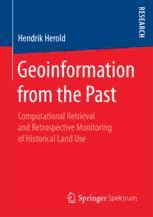
Geoinformation from the Past: Computational Retrieval and Retrospective Monitoring of Historical Land Use PDF
Preview Geoinformation from the Past: Computational Retrieval and Retrospective Monitoring of Historical Land Use
Hendrik Herold Geoinformation from the Past Computational Retrieval and Retrospective Monitoring of Historical Land Use Geoinformation from the Past Hendrik Herold Geoinformation from the Past Computational Retrieval and Retrospective Monitoring of Historical Land Use Hendrik Herold Dresden, Germany Dissertation Dresden University of Technology, Germany, 2015 ISBN 978-3-658-20569-0 ISBN 978-3-658-20570-6 (eBook) https://doi.org/10.1007/978-3-658-20570-6 Library of Congress Control Number: 2017963886 Springer Spektrum © Springer Fachmedien Wiesbaden GmbH 2018 This work is subject to copyright. All rights are reserved by the Publisher, whether the whole or part of the material is concerned, specifically the rights of translation, reprinting, reuse of illustrations, recitation, broadcasting, reproduction on microfilms or in any other physical way, and transmission or information storage and retrieval, electronic adaptation, computer software, or by similar or dissimilar methodology now known or hereafter developed. The use of general descriptive names, registered names, trademarks, service marks, etc. in this publication does not imply, even in the absence of a specific statement, that such names are exempt from the relevant protective laws and regulations and therefore free for general use. The publisher, the authors and the editors are safe to assume that the advice and information in this book are believed to be true and accurate at the date of publication. Neither the publisher nor the authors or the editors give a warranty, express or implied, with respect to the material contained herein or for any errors or omissions that may have been made. The publisher remains neutral with regard to jurisdictional claims in published maps and institutional affiliations. Printed on acid-free paper This Springer Spektrum imprint is published by Springer Nature The registered company is Springer Fachmedien Wiesbaden GmbH The registered company address is: Abraham-Lincoln-Str. 46, 65189 Wiesbaden, Germany Preface Cartographicdocumentsareconsideredtobeuniquestoragesforgeospatial information;storagesbasicallyforcenturiessincePtolemy’sGeographikeHy- phegesis,ifnotearlier. Thischaracteristicmakeshistoricalmapsexceedingly valuableresourcesnotonlyforgeoscientific,geographic,andlandscapere- search,butalsothedigitalhumanities. Inparticular,archivalmapscangive spatiallyexplicitevidenceofthedynamiclandchangethathastakenplace duringthelasttwocenturies,acrucialperiodproposedastheAnthropocene. However,thisgeohistoricalinformationisconcealedinthedocumentsand usuallyonlyvisuallyaccessible. Thisbooksummarizesmorethantenyears ofresearchonthecomputationalacquisitionofretrospectivegeoinformation fromtopographicmapsandisbasedontheauthor’sdoctoraldissertation. Althoughitisaworkofanindividual, suchanendeavorisalwaysaccom- paniedandsupportedbynumerouspeople. Iwanttothankmyacademic advisorsProf. Dr. ElmarCsaplovicsfromDresdenUniversityofTechnology andProf. Dr. NguyenXuanThinhfromUniversityofTechnologyDortmund forreviewingthisworkandtheirvaluablecomments. IamespeciallyinDr. Gotthard Meinel’s debt, my mentor and head of the land use monitoring researchgroupatLeibnizInstituteofEcologicalUrbanandRegionalDeve- lopmentforinitiatingthisresearch,forsupportingmeduringthepastyears, forthespaceforfreethinkingandeventuallyforhispatiencewhilefinishing thiswork. IthankProf. Dr. Dr. BernhardMüllerastheheadoftheLeibniz InstituteofEcologicalUrbanandRegionalDevelopmentfortheinstitutional supportofmyresearch,conferencestays,andtrainings. Furthermore,Iowe thankstoallmyinstitute’scolleagues. Althoughitisimpossibletoaddress them all here, I want to name a few: Dr. Marco Neubert, whose work on imagesegmentationinitiatednotonlymyfirstthesis,butalsoledtovarious publicationsontheevaluationofimagesegmentationalgorithms. Someof theshortcomingsidentifiedinthatearlierworkinspiredpartsofthisresearch. Thankstoalltheinstitute’sfellowdoctoralstudents,whilespecialthanksgo tomyofficemateandPhDfellowDr.RobertHecht. Ithinkwehavelearned a lot during these years of highly intensive work, about both science and life. FurtherIthankDr. MartinBehnischforhisadvice,particularlywhile finishingthiswork. SabineWitschasandUlrichSchumacherforsharingtheir knowledgeabouthistoricalandinternationalmaps. Forprovidingexcellent VI Preface technicalsupportregardingallhard-andsoftwareissuesIthankJörgGössel andCarstenHantzsch. AnjaHellerandAlbrechtRostowskiforthesupport aslibrarians,SieglindeSauerfortheorganizationalsupport. Dr. GerdLintz for his advice during my time as the representative as well as member of thedoctoralcommitteeboard. IalsothankmyDiploma,Master’sandBach- elor’sstudents,amongstthemUlrikeSchinke,BenjaminRichterandPatric Röhm, for their support regarding laborious data collection, preparation and processing. I thank Dr. Christine Wessollek, Dr. Rico Vogel, and Dr. PierreKarraschfromDresdenUniversityofTechnologyfortheircomments on parts of the work. Furthermore, I want to thank some people from all around the world, who have contributed with their advice, motivation or inspiration: Dr. HermannKuxfromInstitutoNacionaldePesquisasEspaciais IowethanksforperfectlyorganizingmyresearchvisitatBrazil’sINPEand theinspiringdiscussions. Dr. PrashantReddyMarpufromMasdarUniversity for the discussions on image segmentation algorithms that inspired some ofthemethodologicalapproaches. Prof. Dr. StefanLeykfromUniversityof Colorado for sharing his expertise in the field of automated map analysis, andtogetherwithProf. Dr. Yao-YiChiangfromUniversityofSouthernCali- forniaforinspiringdiscussionsontheperspectivesandstateoftheartinthe researchfield. Dr. PetrPˇridalfromOldmapsonline.organdDr. LynnUsery fromU.S.GeologicalSurveyforencouragingtalksonthefuturedigitalmap repositories. Dr. ManonKohlerfromtheNationalUniversityofSingaporeI thankforhervaluablehintsandthelanguagesupport. IthankAnitaWilke fromthepublisherSpringerNatureforthehelpfulcommentsonthemanu- scriptaswellasthesupportconcerningthefinalbooklayout. Lastnotleast, Ideeplyexpressmygratitudetoallofmyfamilyfortheirlovingsupportand understandingforallthetimeIdedicatedtothisresearchduringthepast years. Iamespeciallyinmyparents’andgrandparents’debtfortheirefforts inteachingmebothholisticandreductionisticviews,intrinsiccuriosity,but also persistence and commitment, needed to cope with the challenges of suchascientificendeavor. Abstract Land use changes have become a major contributor to the anthropogenic globalchange. Theongoingdispersionandconcentrationofthehumanspe- cies,beingattheirordersunprecedentedsinceitsappearance,havealtered Earth’ssurfaceandatmosphere. Theeffectsaresosalientandirreversible thatanewgeologicalepoch,followingtheinterglacialHolocene,hasbeen announced: the“Anthropocene”. Whileitsonsetisbysomescholarsdated back to the Neolithic revolution, it is commonly referred to the late 18th century. Therapideconomicanddemographicgrowthsincetheindustrial revolutionanditsimplicationsgaverisetoanincreasingawarenessofthe pervasiveanthropogeniclandchangeandledtoanurgentneedforsustain- ablestrategiesforlanduseandlandmanagement. Bypreservinglandscape andsettlementpatternsatdiscretepointsintime,archivalgeospatialdata sourcessuchasremotesensingimageryandhistoricalgeotopographicmaps, inparticular,couldgiveevidenceofthedynamiclandusechangeduringthis crucialperiod. Inthiscontext,thisbooksetouttoexplorethepotentialsofretrospective geoinformationformonitoring,communicating,modelingandeventually understandingthecomplexandgraduallyevolvingprocessesoflandcover andlandusechange. Currently, largeamountsofgeospatialdatasources suchasarchivalmapsarebeingworldwidemadeonlineaccessiblebylibrar- iesandnationalmappingagencies. Despitetheirabundanceandrelevance, theusageofhistoricallanduseandlandcoverinformationinresearchisstill oftenhinderedbythelaboriousvisualinterpretation,limitingthetemporal andspatialcoverageofstudies. Thus,thecoreofthethesisisdedicatedto thecomputationalacquisitionofgeoinformationfromarchivalmapsources bymeansofdigitalimageanalysis. Basedonacomprehensivereviewofliter- ature,availabledatasourcesandproposedalgorithms,twomajorchallenges for long-term retrospective information acquisition and change detection were identified: first, the diversity of geographical entity representations overspaceandtime,andsecond,theuncertaintyinherenttoboththedata sourceitselfanditsutilizationforlandchangedetection. To address the former challenge, image segmentation is considered a global non-linear optimization problem. The segmentation methods and theirparametersareadaptivelyadjustedusingametaheuristic,evolutionary VIII Abstract approach. Forpreservingadaptabilityinhighlevelimageanalysis,ahybrid model-anddata-drivenstrategy,combiningaknowledge-basedandaneural netclassifier,isrecommended. Toaddressthesecondchallenge,aprobab- ilisticobject-andfield-basedchangedetectionapproachformodelingthe positional,thematic,andtemporaluncertaintyadherenttobothdataand processing,isdeveloped. Experimentalresultsindicatethesuitabilityofthe methodologyinsupportoflandchangemonitoring. Inconclusion,potentials ofapplicationanddirectionsforfurtherresearcharegiven. Keywords: LandChangeScience,LandUse,Long-TermMonitoring,Anthro- pocene,HistoricalMaps,GIScience,AdaptiveImageAnalysis,Evolutionary Algorithms,NeuralNets,UncertaintyModeling. Résumé Les changements d’occupation des sols imputables à l’homme et ses acti- vitéssontdevenusuncontributeurmajeurdeschangementsglobauxactuels. Ladispersiondel’espècehumainesurTerreainsiquesaconcentrationen certainslieuxsansprécédentdepuisl’apparitiond’HomoSapiens,ontaltéré la surface terrestre et l’atmosphère. Les effets sont d’une telle magnitude etirréversiblesqu’unenouvelleépoquegéologique,suivantl’époqueinter- glaciaireHolocène,aétépromulguée: l’Anthropocène. Alorsquecertains chercheursconsidèrentlarévolutionnéolithiquecommedatededébutde l’Anthropocène,ilestpluscommunémentadmisquecelle-cidébuteraitsoit àlafindu18esièclesoitenmilieudusiècledernieraucommencementde la dite « Grande accélération » période. La croissance démographique et économiquerapidedepuisledébutdelarévolutionindustrielleainsiqueson implicationdansleschangementsactuelsaentrainéuneprisedeconscience croissantedel’intensitédeschangementsd’occupationdessolsinhérentsà l’hommeainsiquedel’urgencedestratégiesdegestiondurabledesterres. Enconservantlesinformationsrelativesauxpaysagesetauxpeuplements endespointsdiscretsdutemps,lessourcesarchivéesdesdonnéesgéospa- tialiséescommelesimagessatellitesetlescartestopographiqueshistoriques peuvent fournir des indices précieux quant à la dynamique paysagère de cettepériodecruciale. Danscecontexte,leprésentlivreentendexplorerlepotentieldesinforma- tionsgéographiquesrétrospectivespoursuivre,communiquer,modéliser,et éventuellement comprendre les processus des changements d’occupation et d’utilisation des sols. Actuellement, d’importante quantité de données géospatialestelsquelescarte-archivessontmisesàdispositionenligneau traversdesbibliothèquesetinstitutscartographiquesnationaux. Malgréleur abondanceetleurpertinence,l’utilisationenrecherchedecesinformations historiquesestsouvententravéeparleurinterprétationvisuellelaborieuse, limitant ainsi la couverture spatio-temporelle de telles études. Aussi, le cœurdecettethèseestdédiéàl’acquisitionautomatiséedesinformations géographiquescontenuesdanslescarte-archivesaumoyend’analysedigitale d’images. Baséesurunerevuedelittératureexhaustiveainsiquesurlesbases de données et algorithmes existants, deux défis majeurs ont été identifiés àl’acquisitionrétrospectived’informationsgéographiquesetàladétection X Résumé deschangementspaysagers: toutd’abordladiversitédesreprésentations dansletempsetl’espacedesentitésgéographiques,etensuite,l’incertitude inhérenteauxsourcesdedonnéesetàleurutilisationpourladétectiondes changementsd’occupationdusol. Afin de relever le premier défi, la segmentation d’image est considérée comme un problème d’optimisation globale non linéaire. Les méthodes de segmentation et ses paramètres sont ajustés de manière adaptative au moyend’uneapprochemétaheuristique. Pourpréserverl’adaptabilitédans l’analysed’imagehaut-niveau,unmodèlehybrideetdesstratégiesorientées donnéescombinantunclassificateuràlafoisexpertetàlafoisneuronale sontrecommandés. Afindereleverleseconddéfi,uneapprocheprobabiliste baséeobjetetterraindedétectiondechangementspourlamodélisationde l’incertitudepositionnelle,thématiqueettemporelleestdéveloppée. Lesré- sultatsexpérimentauxdecetteétudeconfirmentlapertinencedelaméthode danslesuivideschangementspaysagers. Enconclusion,despotentialités d’applicationdelaméthodeetfuturschampsd’investigationsontdonnées. Mot-clés: Dynamiquepaysagère,Occupationdusol,Observationdelongue durée,Anthropocène,Carteshistoriques,Systèmed’InformationGéograph- ique, Traitements et analyses adaptatives d’image, Algorithmes évolution- nistes,Réseauxdeneuronesartificiels,Modélisationd’incertitude.
